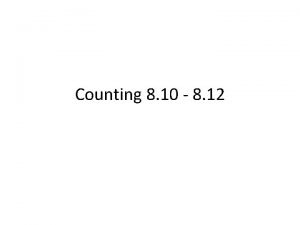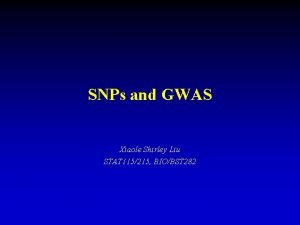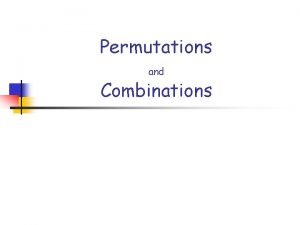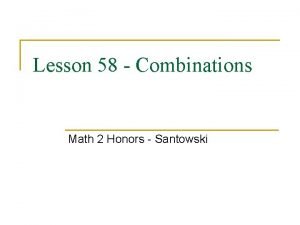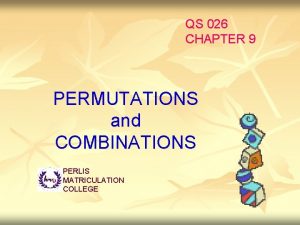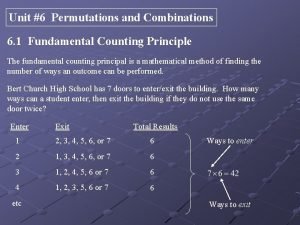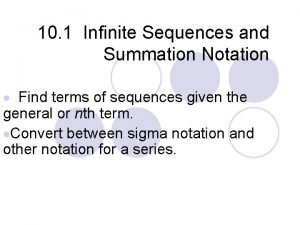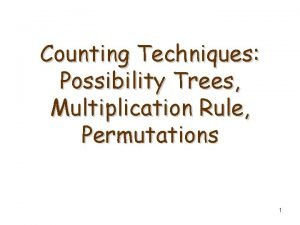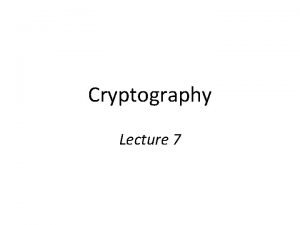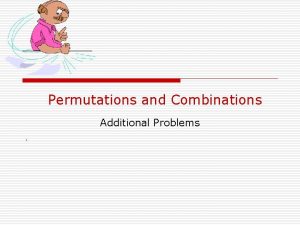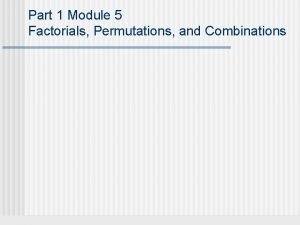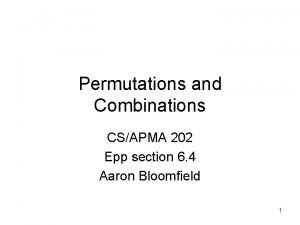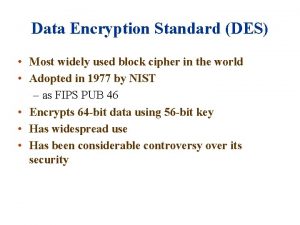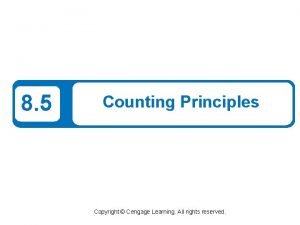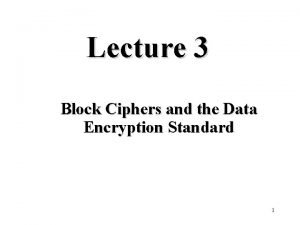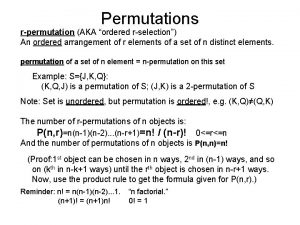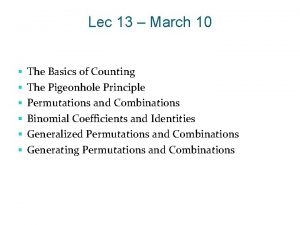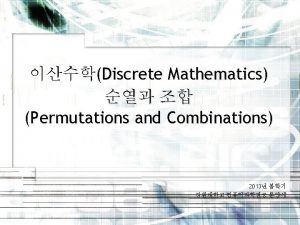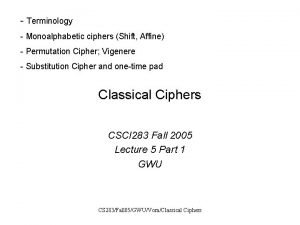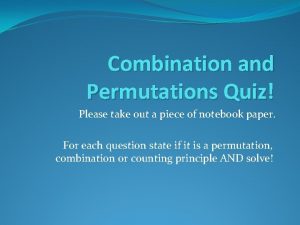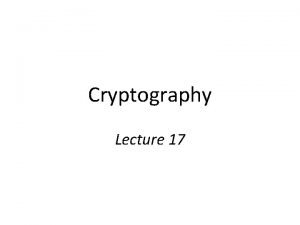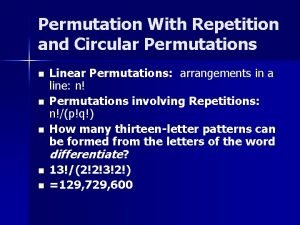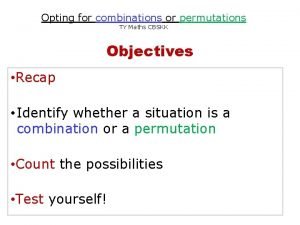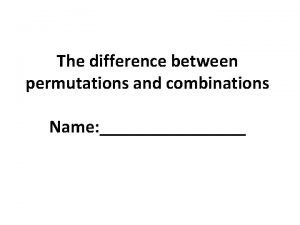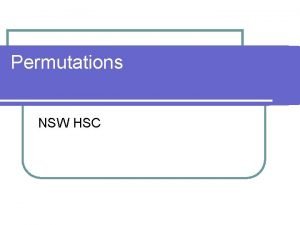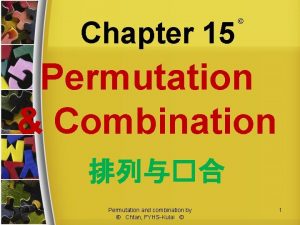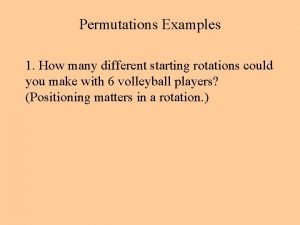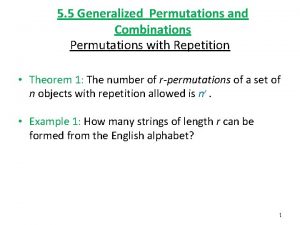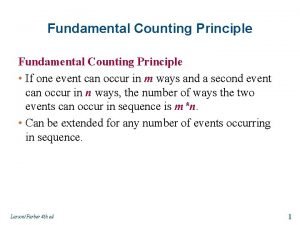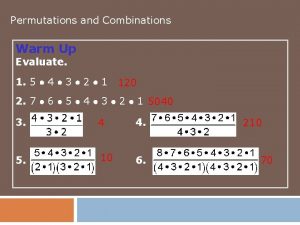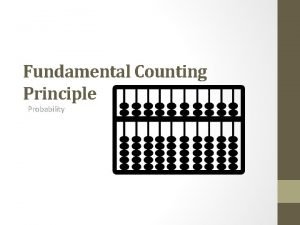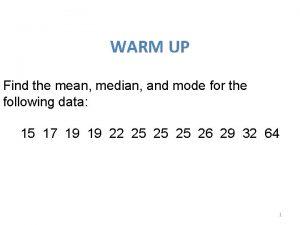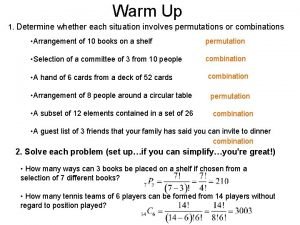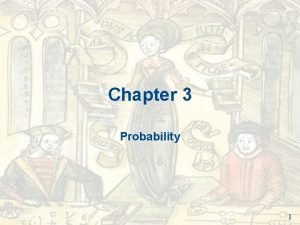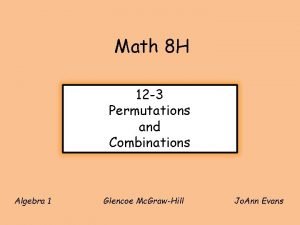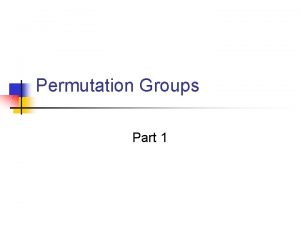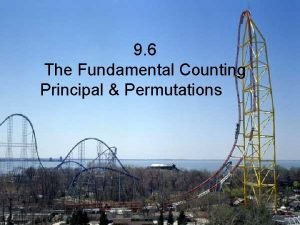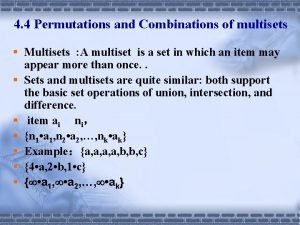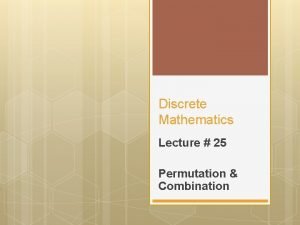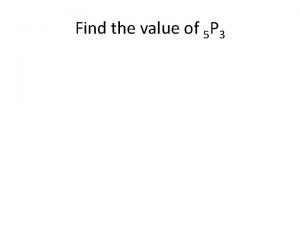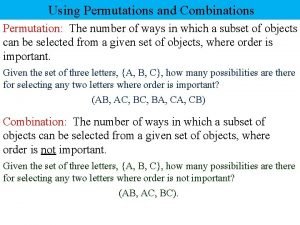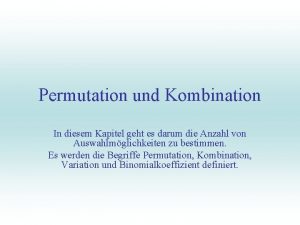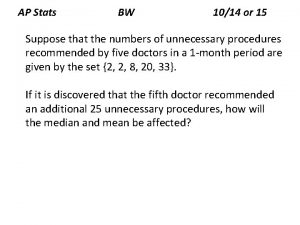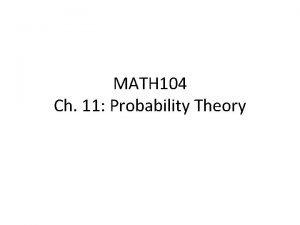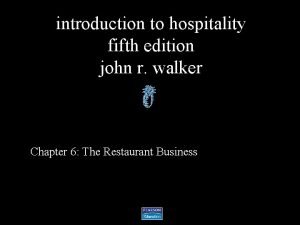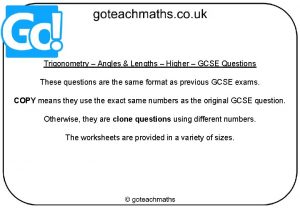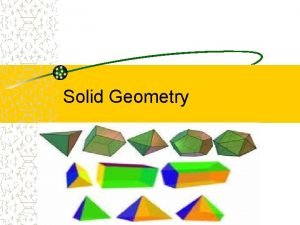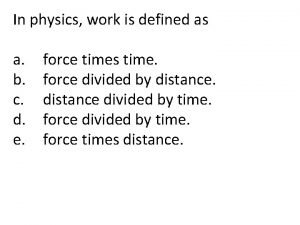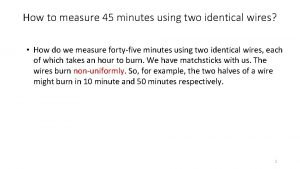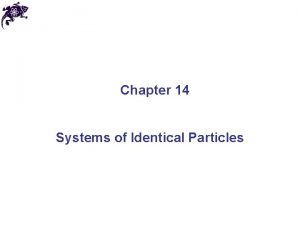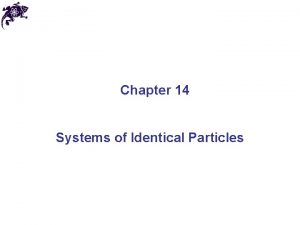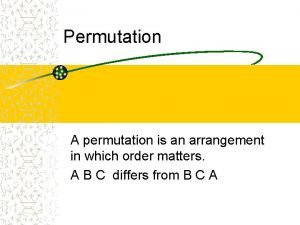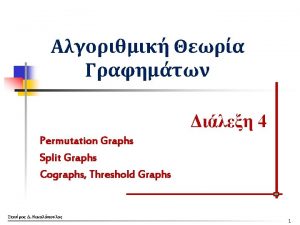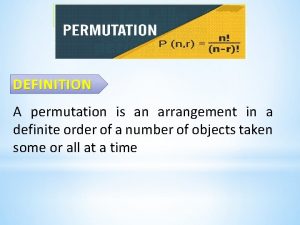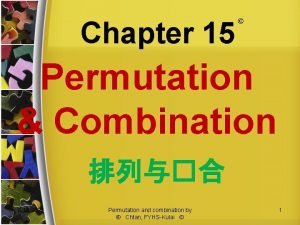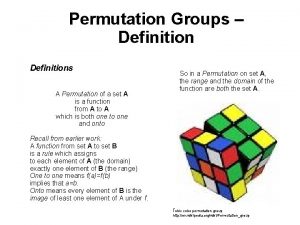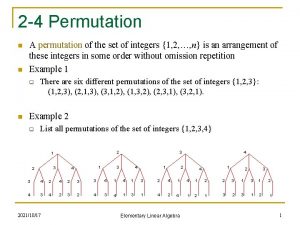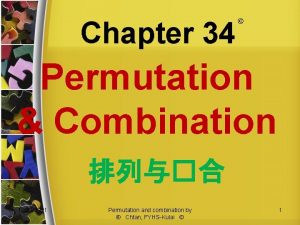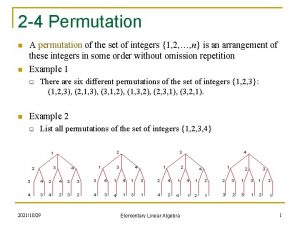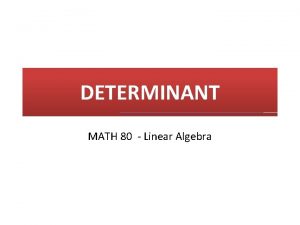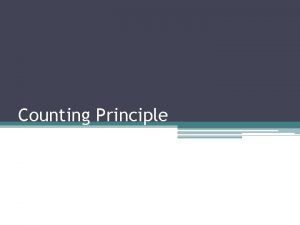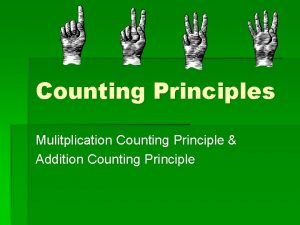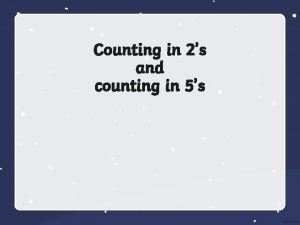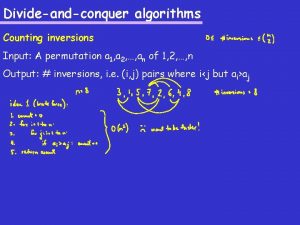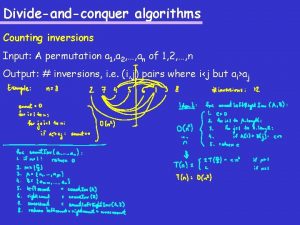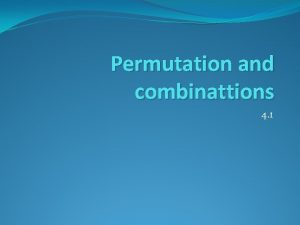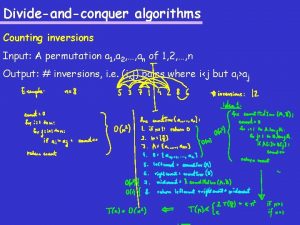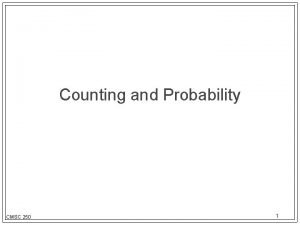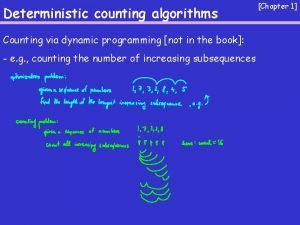Counting 8 10 8 12 Permutation with identical







































































- Slides: 71

Counting 8. 10 - 8. 12

Permutation with identical objects

The expansion of (x+y+z)n • What is the coefficient of xiyjzk where i+j+k = n?

The expansion of (x+y+z)n • What is the coefficient of xiyjzk where i+j+k = n? • (x+y+z)n=(x+y+z). … (x+y+z) (there are n terms) • The coefficient of xiyjzk is the number of ways to select i terms for x; j terms for y and k terms for z.

The expansion of (x+y+z)n •

Natural question • How many terms are there in the expansion of (x+y+z)r? • How many terms of the type xiyjzk are there where i+j+k =r? • (r, 0, 0), (0, r, 0), (0, 0, r), (r-1, 1, 0)…. . are integral solutions of i+j+k = r, where i, j and k are nonnegative. • This is nothing but r-combination, with three (=n) distinct objects. • Ans: C(r+n-1, n-1).

Counting multisets • Multisets – A multiset is a collection that can have multiple instances of the same kind of item.

Combinations with repetitions (Counting multisets) • Example: Consider a set A = {a, b, c, d}. We select two objects from A. – We now consider the following four cases.

Given set of objects = {a, b, c, d} • 2 -permutations with repetitions: 42 = 16 possible cases.

• 2 -permutations without repetitions: P(4, 2) = 12 possible cases.

• 2 -combinations without repetitions: C(4, 2) = 6 possible cases.

• 2 -combinations with repetitions: C(5, 3) = 10 possible cases.

• 2 -combinations with repetitions: C(5, 3) = 10 possible cases. Note that combinations with repetitions do not correspond to subsets of a set.

Combinations with repetitions • Example: Consider a set A = {a, b, c, d}. We select two 10 objects from A with repetitions. – aaaabbbbbd (order is not important) • selected a four times; • selected b five times and • selected d one time

Combinations with repetitions • Example: Consider a set A = {a, b, c, d}. We select two 10 objects from A with repetitions. – aaaabbbbbd (order is not important) • selected a four times; • selected b five times and • selected d one time – bbbaaacccd (another combination)

Combinations with repetitions • Example: Consider a set A = {a, b, c, d}. We select two 10 objects from A with repetitions. – aaaabbbbbd (order is not important) • selected a four times; a b c d • selected b five times and x x | x x x | | x • selected d one time – bbbaaacccd (another combination) a b c d x x x | x

Combinations with repetitions • Example: Consider a set A = {a, b, c, d}. We select two 10 (r) objects from A (n=|A|) with repetitions. – aaaabbbbbd (order is not important) • selected a four times; a b c d • selected b five times and x x | x | • selected d one time a b c d – bbbaaacccd (another combination) x x x | – another combination a b c d | x x x | x x

Example • Seven students where each of them has one item from: cheeseburger, hot dog, taco and fish sandwich. How many different purchases are possible? • Some possible purchases:

Example • Equivalent bar notation • • Thus we have to arrange 7 x’s and (n-1) bars( | ). This is an arrangement of 10 objects using seven x and three |. • This is the same as

Theorem: The number of r-combinations with repetition allowed, that can be selected from a set of size n is

Proof: 1 st XX • • 2 nd 3 rd …. X nth XXX r X’s and n-1 boundaries. These can be arranged in any order. The number of ways this can be done is C(r+n-1, r) = C(r+n-1, n-1) = • Thus the number of r-combinations with repetitions allowed is

Example • I want to buy 5 cans of soft drink. • The possible drinks that are available are coke, sprite and pepsi, where there are unlimited number of each. • In how many ways can I choose the 5 cans? Answer: • This is same as the number of 5 -combinations, with repetition allowed, from a set of size 3. • (since I need to select 5 cans from a set of size 3 with repetition allowed) Using theorem, this can be done in C(5+3 -1, 3 -1) ways.

Example • How many integral solutions of equation x 1+x 2+x 3=20, where x 1, x 2, x 3 0 are there? (3, 4, 13) is a solution; (4, 3, 13) is also a solution; (0, 0, 20) is a solution

Example • How many integral solutions of equation x 1+x 2+x 3=20, where x 1, x 2, x 3 0 are there? Answer: • Note that we can consider x 1, x 2, x 3 as different types. • Choosing xi=t, would mean that we are taking t copies of xi. • This is same as the number of 20 -combinations, with repetition allowed, from a set of objects of size 3. Using theorem, this can be done in C(20+3 -1, 3 -1) ways.

Another view • Equivalent: How many ways can you place r indistinguishable balls in n distinguishable boxes? Ans: = C(r+n-1, n-1)

Permutations and combinations with and without repetitions. n = Number of distinct objects r = number of objects to be selected

Example • A doughnut shop has plain doughnuts, cherry doughnuts, chocolate doughnuts, almond doughnuts, apple doughnuts, broccoli doughnuts. How many ways are there to choose: (a) a dozen doughnuts?

Example • A doughnut shop has plain doughnuts, cherry doughnuts, chocolate doughnuts, almond doughnuts, apple doughnuts, broccoli doughnuts. How many ways are there to choose: (a) a dozen doughnuts? 12 indistinguishable balls and 6 bins Ans: C(12+6 -1, 6 -1) = C(17, 5) = C(17, 12)

Example • A doughnut shop has plain doughnuts, cherry doughnuts, chocolate doughnuts, almond doughnuts, apple doughnuts, broccoli doughnuts. How many ways are there to choose: (b) three dozen doughnuts?

Example • A doughnut shop has plain doughnuts, cherry doughnuts, chocolate doughnuts, almond doughnuts, apple doughnuts, broccoli doughnuts. How many ways are there to choose: (b) three dozen doughnuts? 36 doughnut 36 indistinguishable balls and 6 bins Ans: C(36+6 -1, 6 -1) = C(41, 5) = C(41, 36)

Example • A doughnut shop has plain doughnuts, cherry doughnuts, chocolate doughnuts, almond doughnuts, apple doughnuts, broccoli doughnuts. How many ways are there to choose: (c) two dozen doughnuts with at least two of each kind?

Example • A doughnut shop has plain doughnuts, cherry doughnuts, chocolate doughnuts, almond doughnuts, apple doughnuts, broccoli doughnuts. How many ways are there to choose: (c) two dozen doughnuts with at least two of each kind? Pick first two of each kind. Thus the answer is the number of ways of choosing the remaining dozen. Ans: C(12+6 -1, 6 -1) = C(17, 5) = C(17, 12)

Example • A doughnut shop has plain doughnuts, cherry doughnuts, chocolate doughnuts, almond doughnuts, apple doughnuts, broccoli doughnuts. How many ways are there to choose: (d) two dozen doughnuts with no more than two broccoli doughnuts?

Example • A doughnut shop has plain doughnuts, cherry doughnuts, chocolate doughnuts, almond doughnuts, apple doughnuts, broccoli doughnuts. How many ways are there to choose: (d) two dozen doughnuts with no more than two broccoli doughnuts? We will add up three cases: no broccoli doughnut, exactly one broccoli doughnut, exactly two broccoli doughnuts. These numbers are: C(24 +5 -1, 5 -1) (0 broccoli doughnut); C(23 +5 -1, 5 -1) (1 broccoli doughnut); C(22+5 -1, 5 -1) (2 broccoli doughnuts)

Example • A doughnut shop has plain doughnuts, cherry doughnuts, chocolate doughnuts, almond doughnuts, apple doughnuts, broccoli doughnuts. How many ways are there to choose: (e) two dozen doughnuts at least five chocolate doughnuts and at least three almond doughnuts?

Example • A doughnut shop has plain doughnuts, cherry doughnuts, chocolate doughnuts, almond doughnuts, apple doughnuts, broccoli doughnuts. How many ways are there to choose: (e) two dozen doughnuts at least five chocolate doughnuts and at least three almond doughnuts? We have already chosen the first 8, so need to select the remaining 16. There are C(16+6 -1, 6 -1) ways to do this.

Example • A doughnut shop has plain doughnuts, cherry doughnuts, chocolate doughnuts, almond doughnuts, apple doughnuts, broccoli doughnuts. How many ways are there to choose: (e) two dozen doughnuts with at least one plain, at least two cherry, at least three chocolate, at least one almond, at least two apple, no more than three broccoli doughnuts?

Example • A doughnut shop has plain doughnuts, cherry doughnuts, chocolate doughnuts, almond doughnuts, apple doughnuts, broccoli doughnuts. How many ways are there to choose: (e) two dozen doughnuts with at least one plain, at least two cherry, at least three chocolate, at least one almond, at least two apple, no more than three broccoli doughnuts? We have already chosen the first nine doughnuts. We need determine the ways to distribute 15 doughnuts without choosing more than 3 broccoli doughnuts. The answer is C(15+5 -1, 5 -1) + C(14+5 -1, 5 -1) + C(13+5 -1, 5 -1) + C(12+5 -1, 5 -1).

Example • How many terms are there in the expansion of (w + x + y + z)100?

Example • How many terms are there in the expansion of (w + x + y + z)100? – each term of in the expansion of (w + x + y + z)100 is of the form wa xb yc zd where a +b + c + d =100 where a, b, c, d are nonnegative integers. – Therefore, the answer is C(100+4 -1, 4 – 1).

Review • Given n distinct objects, select r objects where repetitions are allowed. How many ways can you select r objects. • Equivalent: Given n distinct objects in a bag, select r objects with replacement. How many ways can you select r objects. • Equivalent: Given r Xs and n-1 bars (|), how many ways can you select a list of size (r+n-1) involving Xs and |s?

Review • Given n distinct objects, select r objects where repetitions are allowed. How many ways can you select r objects. • Equivalent: Given n distinct objects in a bag, select r objects with replacement. How many ways can you select r objects. • Equivalent: Given r Xs and n-1 bars (|), how many ways can you select a list of size (r+n-1) involving Xs and |s? Ans: C(r+n-1, n-1)

Review • Equivalent: How many ways can you place r indistinguishable balls in n distinguishable boxes?

Review • Equivalent: How many ways can you place r indistinguishable balls in n distinguishable boxes? Ans: = C(r+n-1, n-1)

Review • Determine the number of integral solutions to x 1 + x 2+ …. . + xn = r where x 1 ≥ 0, x 2 ≥ 0, ……, xn ≥ 0.

Review • Determine the number of integral solutions to x 1 + x 2+ …. . + xn = r where x 1 ≥ 0, x 2 ≥ 0, ……, xn ≥ 0. Ans: C(r+n-1, n-1)


• Given any three values n 1, n 2, n 3 ≤ 100, we can assign the largest value as i, the least value as k, and the remaining one as j. • There is a direct correspondence between the number of printing lines with the number of 3 -combinations with repetitions from a set of 100 distinct objects. This is equivalent to selecting three integers from the set {1, 2, …, 100} with repetitions. (Here balls = 3; bins = 100) The answer is C(3+100 -1, 100 -1) = C(102, 99).

Problem • Determine all possible ways to write number n as a sum of positive integers. For n = 4, – 4, 3+1, 1+3, 2+2, 2+1+1, 1+2+1, 1+1+2, 1+1+1+1 – note that we are treating 2+1+1 and 1+2+1 to be different.

Problem • Determine all possible ways to write number n as a sum of positive integers. For n = 4, – 4, 3+1, 1+3, 2+2, 2+1+1, 1+2+1, 1+1+2, 1+1+1+1 – note that we are treating 2+1+1 and 1+2+1 to be different. • How many to write number n using two summands? – for n=7, the possible ways are: 1+6, 2+5, 3+4, 5+2, 6+1 – Let x represent the first term and y represent the second term. – Therefore, for two summands, the answer is the number of integral solutions to x + y = n, x ≥ 1 and y ≥ 1. (C((n-2) + 2 -1, 2 -1))

Problem • Determine all possible ways to write number n as a sum of positive integers. For n = 4, – 4, 3+1, 1+3, 2+2, 2+1+1, 1+2+1, 1+1+2, 1+1+1+1 – note that we are treating 2+1+1 and 1+2+1 to be different. • How many to write number n using two summands? – for n=7, the possible ways are: 1+6, 2+5, 3+4, 5+2, 6+1 – Let x represent the first term and y represent the second term. – Therefore, for two summands the answer is the number of integral solutions to x + y = n, x ≥ 1 and y ≥ 1. (C((n-2) + 2 -1, 2 -1)) – (3 summands) The answer is the number of integral solutions to x + y + z = n, x ≥ 1, y ≥ 1 and z ≥ 1. (C((n-3) + 3 -1, 3 -1)).

Balls in Boxes • Many problems can be formulated as a balls in boxes problem. Suppose we have r balls which are to be placed in n boxes. • • Balls are distinguishable (distinct) or not? Boxes have limited capacity or infinite capacity? Boxes are required to be non-empty?

Balls in Boxes • We will only consider the cases where Boxes are distinguishable. The question when boxes are indistinguishable is hard. • Case I: r distinguishable balls are to be placed in n distinguishable boxes with infinite capacity. • We can divide the job into r tasks. – Ti: place the i-th ball. (i=1 to r) – Ti can be done in n ways (one can select any of the boxes). • Using the multiplication rule, number of ways to do the job is n r.

Balls in Boxes • Case II: r indistinguishable balls are to be placed in n distinguishable boxes with infinite capacity. 1 st XX 2 nd X 3 rd …. n th XXX Choosing r-combination from a set of size n with repetition allowed. • This can be done in C(r+n-1, n-1) ways by theorem done earlier.

Balls in Boxes • Case III: r distinguishable balls are to be placed in n distinguishable boxes with capacity =1. – n<r – n r 0 ways P(n, r) ways

Balls in Boxes • Case IV: r indistinguishable balls are to be placed in n distinguishable boxes with capacity =1. – n < r 0 ways – n r ways

Balls in Boxes: non-empty boxes. • Case V: r indistinguishable balls are to be placed in n distinguishable boxes, with unlimited capacity such that each box is non-empty. – r < n: 0 ways. – r n Give one ball to each box. Now distribute the remaining r-n balls in n boxes, without the non-empty constraint.

Balls in Boxes: non-empty boxes. • Case VI: r indistinguishable balls are to be placed in n distinguishable boxes, with capacity = 1, such that each box is non-empty. – If r = n: 1 way. – If r n : 0 way.

It is important to recognize the equivalence of the following • The number of integer solutions of the equation x 1 + x 2 + … + xn = r where xi ≥ 0 for all 1 ≤ i ≤ n. • The number of choices, with repetitions, of size r from a collection of n objects. • The number of choices of distributing r indistinguishable balls to n bins with no restriction (i. e. a bin can get no ball). • The number of ways of placing r indistinguishable balls in n distinct bins. • Total number of integral solutions = C(r+n-1, n-1)

Example • A doughnut shop has plain doughnuts, cherry doughnuts, chocolate doughnuts, almond doughnuts, apple doughnuts, broccoli doughnuts. How many ways are there to choose: (e) two dozen doughnuts with at least one plain, at least two cherry, at least three chocolate, at least one almond, at least two apple, no more than three broccoli doughnuts? x 1 = # of plain; x 2 = # of cherry; x 3 = # of chocolate; x 4 = # of almond; x 5 = # apple; x 6 = # of broccoli Problem: Number of integral solutions to x 1+ x 2 + x 3 + x 4 + x 5 + x 6 = 24; x 1 ≥ 1, x 2≥ 2, x 3 ≥ 3, x 4 ≥ 1, x 5 ≥ 2, x 6 ≤ 3.

Example • Problem: Number of integral solutions to x 1+ x 2 + x 3 + x 4 + x 5 + x 6 = 24; x 1 ≥ 1, x 2≥ 2, x 3 ≥ 3, x 4 ≥ 1, x 5 ≥ 2, x 6 ≤ 3. We solve the problem when x 6 = 0, when x 6 = 1, when x 6 = 2, and when x 6 = 3.

Example • Problem: Number of integral solutions to x 1+ x 2 + x 3 + x 4 + x 5 + x 6 = 24; x 1 ≥ 1, x 2≥ 2, x 3 ≥ 3, x 4 ≥ 1, x 5 ≥ 2, x 6 ≤ 3. We solve the problem when x 6 = 0, when x 6 = 1, when x 6 = 2, and when x 6 = 3. • When x 6 = 2 : – x 1+ x 2 + x 3 + x 4 + x 5 = 22; x 1 ≥ 1, x 2≥ 2, x 3 ≥ 3, x 4 ≥ 1, x 5 ≥ 2. Not in standard form. All xi must be at least zero.

Example • Problem: Number of integral solutions to x 1+ x 2 + x 3 + x 4 + x 5 + x 6 = 24; x 1 ≥ 1, x 2≥ 2, x 3 ≥ 3, x 4 ≥ 1, x 5 ≥ 2, x 6 ≤ 3. We solve the problem when x 6 = 0, when x 6 = 1, when x 6 = 2, and when x 6 = 3. • When x 6 = 2 : – x 1+ x 2 + x 3 + x 4 + x 5 = 22; x 1 ≥ 1, x 2≥ 2, x 3 ≥ 3, x 4 ≥ 1, x 5 ≥ 2. – set x 1 = y 1 +1; x 2 = y 2 +2; x 3 = y 3 +3; x 4 = y 4 +1; x 5 = y 5 +2 – Problem becomes: • (y 1+1)+ (y 2 + 2) + (y 3 +3) + (y 4 +1) + (y 5+1) = 22; y 1, y 2, y 3, y 4, y 5 ≥ 0. • y 1+ y 2 + y 3 + y 4 + y 5 = 14; y 1, y 2, y 3, y 4, y 5 ≥ 0.

Example • Problem: Number of integral solutions to x 1+ x 2 + x 3 + x 4 + x 5 + x 6 = 24; x 1 ≥ 1, x 2≥ 2, x 3 ≥ 3, x 4 ≥ 1, x 5 ≥ 2, x 6 ≤ 3. We solve the problem when x 6 = 0, when x 6 = 1, when x 6 = 2, when x 6 = 3. • When x 6 = 2 : – x 1+ x 2 + x 3 + x 4 + x 5 = 22; x 1 ≥ 1, x 2≥ 2, x 3 ≥ 3, x 4 ≥ 1, x 5 ≥ 2. – set x 1 = y 1 +1; x 2 = y 2 +2; x 3 = y 3 +3; x 4 = y 4 +1; x 5 = y 5 +2 – Problem becomes: • (y 1+1)+ (y 2 + 2) + (y 3 +3) + (y 4 +1) + (y 5+1) = 22; y 1, y 2, y 3, y 4, y 5 ≥ 0. • y 1+ y 2 + y 3 + y 4 + y 5 = 14; y 1, y 2, y 3, y 4, y 5 ≥ 0. Ans: C(14+5 -1, 5 -1)

Subtraction method • Problem: Number of integral solutions to x 1+ x 2 + x 3 + x 4 + x 5 + x 6 = 24; x 1 ≥ 1, x 2≥ 2, x 3 ≥ 3, x 4 ≥ 1, x 5 ≥ 2, x 6 ≤ 3. • Solution • Compute the number of integral solutions (A) to – x 1+ x 2 + x 3 + x 4 + x 5 + x 6 = 24; x 1 ≥ 1, x 2≥ 2, x 3≥ 3, x 4≥ 1, x 5 ≥ 2, x 6 ≥ 0 • Compute the number of integral solutions (B) to – x 1+ x 2 + x 3 + x 4 + x 5 + x 6 = 24; x 1 ≥ 1, x 2≥ 2, x 3≥ 3, x 4≥ 1, x 5 ≥ 2, x 6 ≥ 4 • The answer to the original problem: A – B.

Another variation • Number of integral solutions to – y 1+ y 2 + y 3 + y 4 + y 5 ≤ 14; y 1, y 2, y 3, y 4, y 5 ≥ 0. • Answer is the sum of the integral solutions to – – – y 1+ y 2 + y 3 + y 4 + y 5 = 14; y 1, y 2, y 3, y 4, y 5 ≥ 0, and y 1+ y 2 + y 3 + y 4 + y 5 = 13; y 1, y 2, y 3, y 4, y 5 ≥ 0, and y 1+ y 2 + y 3 + y 4 + y 5 = 12; y 1, y 2, y 3, y 4, y 5 ≥ 0, and … … y 1+ y 2 + y 3 + y 4 + y 5 = 0 ; y 1, y 2, y 3, y 4, y 5 ≥ 0.

Another variation • Number of integral solutions to – y 1+ y 2 + y 3 + y 4 + y 5 ≤ 14; y 1, y 2, y 3, y 4, y 5 ≥ 0. • Answer is the sum of the integral solutions to – – – y 1+ y 2 + y 3 + y 4 + y 5 = 14; y 1, y 2, y 3, y 4, y 5 ≥ 0, and y 1+ y 2 + y 3 + y 4 + y 5 = 13; y 1, y 2, y 3, y 4, y 5 ≥ 0, and y 1+ y 2 + y 3 + y 4 + y 5 = 12; y 1, y 2, y 3, y 4, y 5 ≥ 0, and … … y 1+ y 2 + y 3 + y 4 + y 5 = 0 ; y 1, y 2, y 3, y 4, y 5 ≥ 0. • Same as the number of integral solutions to – y 1+ y 2 + y 3 + y 4 + y 5 + s = 14; y 1, y 2, y 3, y 4, y 5, s ≥ 0




This one is surprisingly difficult. Realizes Stirling numbers of the second kind.
 Permutation with identical objects
Permutation with identical objects Identical by descent vs identical by state
Identical by descent vs identical by state Basic counting principle
Basic counting principle Permutation and combination meaning
Permutation and combination meaning Permutation and combination matriculation
Permutation and combination matriculation Permutation with restrictions
Permutation with restrictions Permutation tree diagram
Permutation tree diagram Sigma notation for sums
Sigma notation for sums Counting multiplication rule
Counting multiplication rule Keyed permutation
Keyed permutation Permutation without repetition
Permutation without repetition Permutation and factorial
Permutation and factorial What are permutations and combinations
What are permutations and combinations Permutation fugue
Permutation fugue Bit permutation
Bit permutation The most widely used encryption standard is
The most widely used encryption standard is Naanab
Naanab Des
Des Ordered arrangement
Ordered arrangement Permutation formula
Permutation formula Difference between permutation and combination
Difference between permutation and combination Atbash cipher
Atbash cipher Combination or permutation quiz
Combination or permutation quiz Formula of permutation
Formula of permutation Keyed permutation
Keyed permutation Circular permutation with restriction
Circular permutation with restriction A voicemail system password is 1 letter
A voicemail system password is 1 letter 10 sentences comparing permutations and combinations
10 sentences comparing permutations and combinations Types of permutation
Types of permutation Permutation and combination
Permutation and combination Volleyball rotations 1-6
Volleyball rotations 1-6 Indistinguishable permutations
Indistinguishable permutations What is distinguishable permutation meaning
What is distinguishable permutation meaning How many ways can a stylist arrange 5 of 8
How many ways can a stylist arrange 5 of 8 Tree diagram and fundamental counting principle
Tree diagram and fundamental counting principle 4 letter call signs
4 letter call signs Determine
Determine Multinomial theorem in permutation and combination
Multinomial theorem in permutation and combination Subjective probability example
Subjective probability example Combinations in math
Combinations in math Permutation group notation
Permutation group notation Rsa encryption online
Rsa encryption online Permutation probabilité
Permutation probabilité Site:slidetodoc.com
Site:slidetodoc.com Permutation cipher decoder
Permutation cipher decoder Multiset combinations
Multiset combinations Permutation and combination in discrete mathematics
Permutation and combination in discrete mathematics Permutation
Permutation Combination formula derivation
Combination formula derivation Combinations and permutations
Combinations and permutations When permutation and when combination
When permutation and when combination Bit permutation
Bit permutation Permutation und kombination
Permutation und kombination What is distinguishable permutation meaning
What is distinguishable permutation meaning 20p3 permutation
20p3 permutation Fraternal twins pedigree
Fraternal twins pedigree Groups of restaurants identical in market
Groups of restaurants identical in market The diagram shows 3 identical circles inside a rectangle
The diagram shows 3 identical circles inside a rectangle Paraphrasing proverbs
Paraphrasing proverbs Pedigree symbol for identical twins
Pedigree symbol for identical twins The rapid manufacture of large numbers of identical objects
The rapid manufacture of large numbers of identical objects Rita and holly are identical twins
Rita and holly are identical twins Placement of diacritics is examining
Placement of diacritics is examining Rita and holly are identical twins
Rita and holly are identical twins Represented above are five identical balloons
Represented above are five identical balloons Identical vs fraternal twins
Identical vs fraternal twins A solid object with two identical ends and flat sides
A solid object with two identical ends and flat sides In physics, work is defined as *
In physics, work is defined as * This ameba would most likely be classified as a
This ameba would most likely be classified as a Identical product
Identical product How to measure 45 minutes using two identical wires
How to measure 45 minutes using two identical wires What is nurture in psychology
What is nurture in psychology
